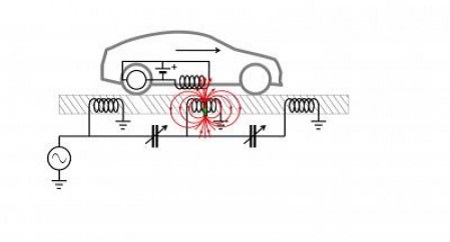One of the biggest obstacles to widespread acceptance and usage of electric vehicles (EVs) is range. American motorists are simply reluctant to buy an automobile that they can only drive for 100 miles at a time. This “range anxiety” is compounded by two other elements: The charging infrastructure in the U.S. is still in its infancy, meaning there just are not that many places to juice up; and charging an EV requires a pretty substantial investment of time—sometimes up to eight hours. This makes a long road trip in an EV next to impossible.
But what if there were alternatives? What if we could continually charge an EV while were were driving it? What if we never had to worry about charging stations? What if our highways were the charging stations?

That’s just what Stanford University researchers may have just discovered. The scientists say they’ve designed a high-efficiency charging system that uses magnetic fields to wirelessly transmit large electric currents between metal coils placed several feet apart. The long-term goal of the research is to develop an all-electric highway that wirelessly charges cars and trucks as they cruise down the road.
The new technology has the potential to dramatically increase the driving range of electric vehicles and eventually transform highway travel, according to the researchers. Their results are published in the journal Applied Physics Letters.
“Our vision is that you’ll be able to drive onto any highway and charge your car,” Shanhui Fan, an associate professor of electrical engineering, said in a statement. “Large-scale deployment would involve revamping the entire highway system and could even have applications beyond transportation.”
The wireless power transfer is based on a technology called magnetic resonance coupling. Two copper coils are tuned to resonate at the same natural frequency—like two wine glasses that vibrate when a specific note is sung. The coils are placed a few feet apart. One coil is connected to an electric current, which generates a magnetic field that causes the second coil to resonate. This magnetic resonance results in the invisible transfer of electric energy through the air from the first coil to the receiving coil.
MIT researchers have created a spinoff company that’s developing a stationary charging system capable of wirelessly transferring about 3 kilowatts (kW) of electric power to a vehicle parked in a garage or on the street. Fan and his colleagues wondered if the MIT system could be modified to transfer 10 kW of electric power over a distance of 6.5 feet—enough to charge a car moving at highway speeds. The car battery would provide an additional boost for acceleration or uphill driving.
Here’s how the system would work: A series of coils connected to an electric current would be embedded in the highway. Receiving coils attached to the bottom of the car would resonate as the vehicle speeds along, creating magnetic fields that continuously transfer electricity to charge the battery.
To determine the most efficient way to transmit 10 kW of power to a real car, the Stanford team created computer models of systems with metal plates added to the basic coil design.